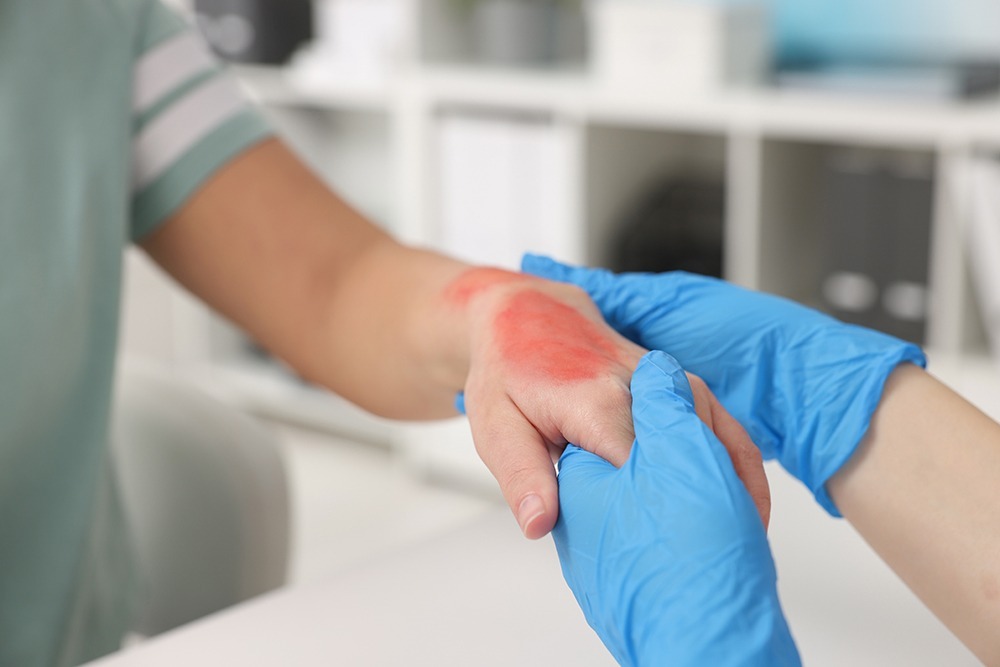Chemical Burn Injuries: Know Your Legal Rights After Hazardous Exposure
Share:
Chemical burns are some of the most painful and dangerous injuries a person can suffer. Unlike a kitchen burn or a fire-related accident, chemical burns don’t stop when the initial contact ends, the corrosive agents can continue damaging skin, nerves, and even internal organs long after exposure. Victims often face long hospital stays, permanent scarring, and staggering medical bills.
But here’s the part many people don’t realize: when chemical burns happen in the workplace, in a lab, or from defective consumer products, victims may have legal options to hold negligent parties accountable. Let’s break it down.
What Exactly Is a Chemical Burn?
A chemical burn occurs when the skin or body tissue is damaged by a corrosive substance, such as strong acids, bases, solvents, or industrial chemicals. Unlike thermal burns, which result from heat, chemical burns penetrate deeper and often continue to cause injury until the chemical is completely neutralized.
Common symptoms include:
- Redness, blistering, or blackened skin.
- Severe pain or numbness if nerves are damaged.
- Vision problems if chemicals contact the eyes.
- Difficulty breathing if toxic fumes were inhaled.
Statistic: According to the American Burn Association, more than 5,000 chemical burns are reported in U.S. workplaces each year, many requiring long-term treatment.
Where Do Chemical Burns Happen?
Chemical burn injuries don’t only occur in labs or industrial plants—they can happen in everyday environments too.
- Workplaces: Factories, construction sites, chemical labs, and even restaurants (think hot grease cleaners).
- Defective Products: Exploding e-cigarettes, leaking batteries, dangerous household cleaners, or mislabeled cosmetics.
- Households: Bleach, drain cleaners, oven sprays, and other strong cleaning supplies.
- Public Spaces: Spills in stores, poorly maintained pools with imbalanced chlorine, or chemical exposure at gyms or spas.
Did You Know? Cleaning agents are among the most common culprits of household chemical burns, and children under five are the most at risk due to accidental ingestion or skin contact.
Medical Treatment and Long-Term Impact
Immediate first aid for chemical burns involves flushing the affected area with water for at least 20 minutes, removing contaminated clothing, and seeking emergency care. But the damage often extends far beyond the initial injury.
- Surgeries and Skin Grafts: Severe burns may require multiple reconstructive procedures.
- Chronic Pain: Nerve damage can cause lifelong discomfort.
- Emotional Trauma: Disfigurement often leads to anxiety, depression, and PTSD.
- Employment Challenges: Victims may be unable to return to work, especially in physically demanding jobs.
Statistic: The average hospitalization for a severe burn injury costs over $200,000, according to the National Center for Biotechnology Information (NCBI).
Legal Options for Chemical Burn Victims
The type of claim you can pursue depends on where and how the exposure occurred.
Workers’ Compensation Claims: If the injury happened on the job, victims may qualify for workers’ compensation benefits, which typically cover:
- Medical expenses.
- Lost wages during recovery.
- Disability benefits if you can’t return to work.
Limitation: Workers’ comp usually does not include pain and suffering.
Personal Injury Lawsuits: If negligence caused the burn, you may pursue a personal injury lawsuit against the responsible party. This applies when:
- Employers fail to provide proper safety gear.
- Businesses ignore OSHA standards.
- Landlords don’t safely store or label chemicals on their property.
In these cases, victims may recover damages for:
- Medical bills (past and future).
- Lost income and diminished earning capacity.
- Pain and suffering.
- Emotional distress and loss of enjoyment of life.
Product Liability Claims: When a defective product is to blame, manufacturers, distributors, or retailers can be held accountable. This applies if:
- A chemical cleaner was mislabeled or lacked safety warnings.
- A product was defectively designed (e.g., exploding lithium batteries).
- A manufacturing defect made the product unsafe.
Pro Tip: Always save the defective product if possible—it can be critical evidence in a lawsuit.
Premises Liability Claims: If the chemical burn occurred on someone else’s property due to unsafe conditions (like a spill in a store or improperly balanced pool chemicals), you may have a premises liability case against the property owner.
Statistic: OSHA reports that more than 190,000 U.S. workers are injured annually by chemical exposure, and thousands of those cases involve employer negligence.
Steps to Take After a Chemical Burn Injury
Taking the right steps after a chemical burn can protect both your health and your legal rights:
- Seek immediate medical attention. Burns worsen quickly.
- Document everything. Take photos of injuries, the chemical container, and the scene.
- Report the incident. To your employer, property manager, or product manufacturer.
- Preserve evidence. Save any clothing, containers, or defective products involved.
- Contact an attorney. The sooner a lawyer investigates, the stronger your case will be.
What Compensation Can Victims Receive?
The value of a chemical burn case depends on the severity of the injury and the negligence involved, but damages often include:
- Medical expenses (ER visits, surgeries, rehabilitation).
- Lost wages and reduced earning potential.
- Pain and suffering.
- Permanent disability or disfigurement.
- Punitive damages in cases of egregious negligence.
Statistic: Severe burn victims typically miss 40+ workdays, creating significant financial hardship without compensation.
Final Thoughts
Chemical burns are life-altering injuries, and too often, they’re the result of negligence, unsafe products, or inadequate safety standards. Victims deserve more than medical care—they deserve justice. Whether through workers’ comp, a personal injury lawsuit, or a product liability claim, legal action can help hold negligent parties accountable and provide the financial support needed for recovery.
If you or a loved one has suffered a chemical burn in Florida, don’t navigate this complex process alone. An experienced attorney can investigate the cause, identify liable parties, and fight for the compensation you need to move forward.
Suffered a Chemical Burn in Florida? Who’s Responsible for Your Injuries?
At DuFault Law, we know chemical burn injuries aren’t just painful—they’re life-changing. Whether your burn was caused by workplace exposure, hazardous chemicals in a lab, or a defective consumer product, you may be entitled to significant compensation.
Our team investigates the cause, identifies all liable parties, and fights for damages covering medical care, lost wages, pain and suffering, and long-term care needs.
- Call us at (239) 422-6400
- Email us at contact@dufaultlaw.com
- Or Visit our Contact Page to schedule a consultation



Comments are closed